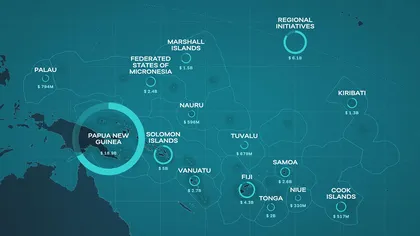Tracking Aid in the Indo-Pacific
The Lowy Institute uses IATI data to strengthen transparency and development effectiveness in the Indo-Pacific region.
The Lowy Institute uses IATI data to shine a light on who funds what, where, and how in the Indo-Pacific region.
Through its flagship South East Asia and Pacific Aid Maps, the Institute tracks development finance flows across 24 countries. These online tools successfully combine multiple data sources to promote the transparency, coordination and effectiveness of aid across these regions.
About the Lowy Institute and its Aid Maps
The Lowy Institute is a leading international policy think tank in Australia. Through its Indo-Pacific Development Centre, the Institute hosts the Southeast Asia Aid Map and the Pacific Aid Map, which provides interactive, publicly available data on aid flows to these regions.

Lowy Institute Pacific Aid Map
The Lowy Institute is a leading international policy think tank in Australia. Through its Indo-Pacific Development Centre, the Institute hosts the Southeast Asia Aid Map and the Pacific Aid Map, which provides interactive, publicly available data on aid flows to these reg
Together, the Maps cover nearly 170,000 aid and development projects funded by 109 bilateral and multilateral development partners.
Together, the Maps cover nearly 170,000 aid and development projects funded by 109 bilateral and multilateral development partners. Data is drawn from IATI, the OECD’s Development Assistance Committee (OECD DAC) and open-source research.
The Maps enable analysis by policy theme—including climate action and gender equality—through tailored filters and are regularly updated. The Lowy Institute uses this data as the foundation for their analysis, including annual reports on the state of aid and development finance for each region as well as other policy briefs, data snapshots and analysis papers.
IATI: Adding Detail to the Development Landscape
The Aid Maps rely on granular financial data, especially at the project and transaction level. IATI’s open data standard makes this possible by enabling near real-time updates to be provided by donors and implementing partners on their financing and activities.
“We require granularity down to the transaction level for projects, which is why IATI is so critical for our work.” — Lowy Institute
The Lowy Institute uses IATI data to:
● View individual project transactions and disbursements
● Analyse data by sector, region, donor, and recipient
● Geo-locate projects and display them on interactive maps
● Understand the results of development activities
Grace Stanhope, Research Associate, Southeast Asia Aid Map at the Lowy Institute said: “We require granularity down to the transaction level for projects, which is why IATI is so critical for our work.”
Combining Data Sources for a Complete Picture
The Lowy Institute uses IATI data to complement other existing development sources, including the OECD’s Creditor Reporting System (CRS).
“We’re tracking information from different development partners involved in the region—traditional ones like Australia, non-traditional partners like China, India, Indonesia and the multilateral development banks”— Lowy Institute
“In the early days of the Aid Maps in 2018, the research team turned to IATI looking for more detail than is available in the OECD DAC CRS, which was our alternative source of data for traditional donors”, said Grace Stanhope.
The Aid Maps team complements this data with extensive desk research to capture a broader range of development finance. By drawing on open sources such as government budgets, embassy websites, media reports and press releases, the team ensures the Maps reflect the full diversity of development partners active in the Indo-Pacific.
Alexandre Dayant, Deputy Director of the Indo-Pacific Development Centre at the Lowy Institute said: “We’re tracking information from different development partners involved in the region—traditional ones like Australia, non-traditional partners like China, India, Indonesia and the multilateral development banks”.
Speaking a IATI’s co-hosted side-event at the Fourth International Conference on Financing for Development (July 2025), Alexandre Dayant provided a live demonstration of the Lowy Institute Pacific Aid Map:
The Lowy Institute’s experience demonstrates the power of combining high-quality open data with rigorous research to deliver impactful development insights and analysis. Their work highlights how IATI data—when used alongside other sources—can support better decision-making, improve coordination, and strengthen accountability.
IATI data and the IATI Standard are important tools for our database to build the most complete picture and analysis”— Lowy Institute
"The quality of our research rests on our data being comparable across different donors – traditional, emerging, multilateral, bilateral, and intra-regional. IATI data and the IATI Standard are important tools for our database to build the most complete picture and analysis” said Riley Duke, Research Fellow, Pacific Aid Map at the Lowy Institute.
This case study shows that the future of development data lies in interoperability: connecting diverse systems, standards, and sources to unlock deeper insights and deliver more effective, transparent development cooperation.